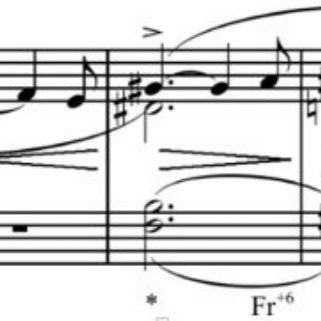Head Down or head up? (part 2)

In part 1 of this article I talked about how Western classical music uses a series of chords to build and then release tension, and that this process has some parallels to how we encounter and resolve (or not resolve) problems in leadership.
Wagner’s prelude to his opera Tristan und Isolde is seen by many musicologists to represent a turning point in the repertoire. Typically composers used perfect cadences to indicate a key, to give a sense of “home”, of resolving the tension. But in this piece, Wagner deliberately avoids perfect cadences. He uses a range of devices to build tension and ambiguity. In fact, the very first chord of the piece was so unusual and so ambiguous that it has been given its own name - the Tristan chord - and it has been hugely influential in the repertoire since.
I think we have lived through a Tristan period. The problems we have encountered have been so unusual and unexpected that we haven’t solved them yet. But in order to resolve them, to “get home”, we must have our heads up.
Heads up leaders don’t ignore the detail, but they do trust others to take care of it.
Head up leaders are clear about the values, vision, ethos and culture of their schools, and communicate these at every opportunity.
Head up leaders make decisions based on these values, rather than necessarily doing the obvious or easiest.
Head up leaders look for ways to turn every challenge into an opportunity. This is more than just positive thinking. One headteacher told me how, every time he has faced a challenge in the Tristan period, he has given himself 5 minutes of thinking time to consider how he might turn this into an opportunity. It’s a practical, constructive tool.
Let me give you an example. All schools responded in March 2020 to the challenge of home learning and the related challenge of online learning. Some were swift, others not. By the second lockdown, most schools had effective online platforms in place. Head down leaders ensured these systems worked well for all students. Head up leaders also thought through how they might enrich the learning experience, both at that time and in the future. Head up leaders continue to use the best of this practice in their schools, including during storm
Some heads down leaders have mainly looked internally during this Tristan period. They have relied on their staff, and often their parent and pupil bodies, to see them through the challenges - testing centres, food voucher distribution and home visits. These have been fantastic achievements.
Heads up leaders have also looked more widely for partnerships to help children to thrive, and that demonstrate the values and ethos of their schools. What might this look like in practice? Here are a few examples from 5 Dimensions Trust during the Tristan period.
Diversity symposium
The trust, in collaboration with MAKE, the local cultural education partnership, hosted an online symposium on diversity and inclusion called MK: Diverse City. This showcased some fantastic practice in diversity from schools, arts and heritage organisations, so that participants could learn and improve their offer in their own settings. You can watch a sample of the event here. Heads up. 
Basketball academy
How might you address poor behaviour, low aspirations, challenging parental engagement, rising gang membership, poor mental, physical and social health amongst large groups of students? One way is to find a good idea, a great partner and to turn it from a set of challenges to win-win opportunities.
By teaming up with Milton Keynes Basketball Club to form the MK5D Basketball Academy the 5 Dimensions Trust has helped the club grow from 200 to almost 1000 members. They share facilities and coaches, creating an academic athlete ethos, where a sense of identity and community spill over from the court into the classroom. A heads up win-win-win for club, school and community. Heads up.
Acceler8 and Ambition Projects
In September 2020 the trust capitalised on the opportunities afforded by online learning to establish its own tutoring provision, Acceler8, and bespoke online learning programmes for students who are able and ambitious, known as Ambition Projects. Each of these initiatives has tried to live out our vision to be a vibrant community of exceptional people. Our actions have been driven by our ethos, and our culture has developed as a result. Heads up.
Ethos and values
I mentioned that Wagner deliberately avoids resolving the tension in his Tristan prelude. Our problems as schools, leaders don’t necessarily disappear.
However, the chord that immediately follows the first, ambiguous Tristan chord is E7, a chord that would usually be followed by the home chord, A. When the next Tristan chord appears, it is followed by G7, pointing to C. On the third time it points towards E. These three notes - A, C and E, outline the very chord Wagner has so far avoided. In other words, hard coded into this ambiguous and unresolved opening section, is the very key he has been reluctant to sound. It’s as though the ethos of A minor is there all along, we just didn’t realise it.
To what extent are the decisions you make driven by your ethos and values? Is your ethos hard-coded into your problem-solving, even when you can’t see it?
Is your head down, concerned mainly with the details, yourself and the present?
Or is your head up, concerned with creativity, opportunity and collaboration for the future?
Where is your head?
